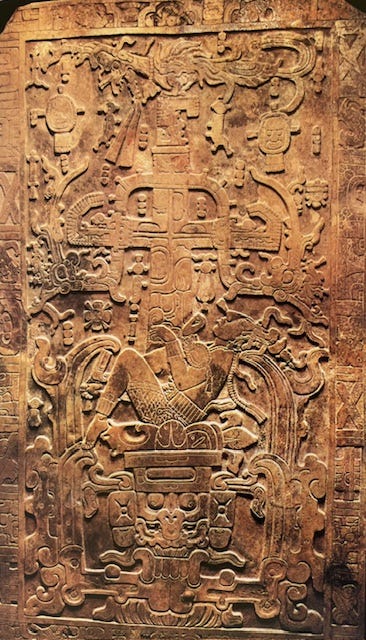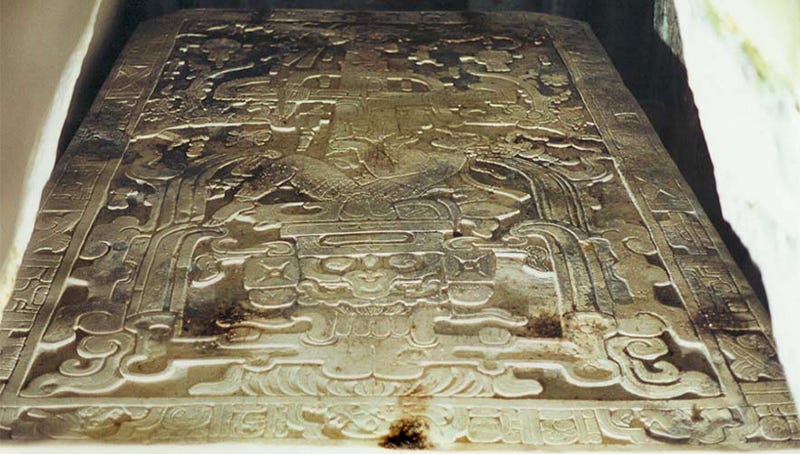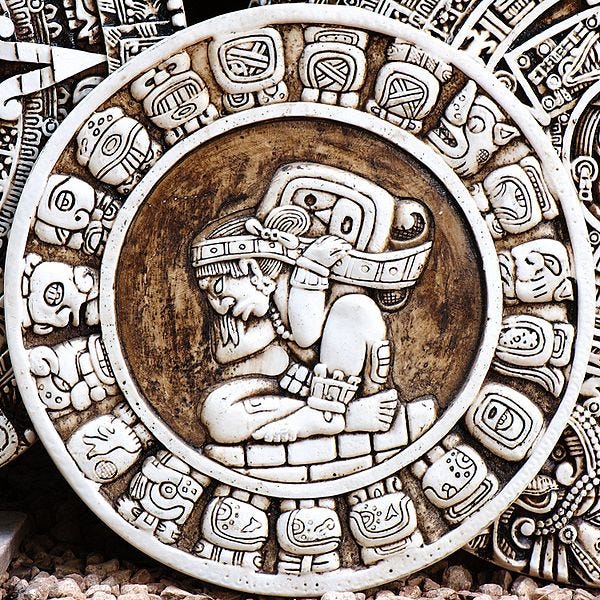Hola Amigos! My fascination with the Maya has led me down many a road— literally and literary—as I've written about once or twice. Okay, maybe more. . . . Since the study of the Maya is fairly new in archeological terms, having first been written about by the western world in mid-1800s after John Lloyd Stephens and Frederick Catherwood explored the Yucatán and Central America, new perceptions still surface. Here are things to consider on my favorite topic of interest: the mystery of the Maya. As a kicker, you may have heard about a recently discovered Maya city in the jungle near impressive Calakmul in southern Mexico. A grad student in anthropology at Tulane found it using LiDAR technology. It was named Valeriana—new news continues from the Maya world.
Who were the ancient Maya? Were they pyramid builders? Astronomers? Lords of the jungle? High priests and shaman? Mathematicians?
After years of studying the Maya, I believe—aside from those glorious pyramids— they’ll most be remembered for their stargazing abilities. The Maya were called naked-eye astronomers.
Say what?
Stargazers and mathematicians
The Maya had a reason to be stargazers. Their rulers took direction from planetary movements, specifically those of Venus, which assisted them in a multitude of ways. These ancient mathematicians, often priests, kept painstakingly detailed records on the position of the sky—day by day, year by year, century by century. With this consistency and the use of nothing other than the naked eye, they recorded precise calculations for more than a millennium.
They kept track of the night sky in paperbark books called codices. (Sadly, all but four were burned by Spanish priests in an effort to purge the Maya of their ‘pagan’ beliefs). Through these precise recordings of the night sky’s movements, the Maya were able to simulate what we today can do in the blink of an eye with a telescope. The Maya viewed the Milky Way as the World Tree, La Ceiba. It was considered the Maya Tree of Life—a tree with branches so large it could hold up the world.
The Milky Way
But to the Maya, the Milky Way was more than that familiar smudge across the sky we see nightly. The Milky Way was also the Sac-be or road, their path to the sky that led dead souls to the underworld—their River Styx. Without the Milky Way, dead souls literally had no road to guide them and would be unable to find their way. They would be caught in an unforgiving limbo.
Maya astronomers were therefore left with the weighty task of deciphering how each star and planet would align. It was their destiny to forever record the nightly movement of the stars so that those departed souls could find their way to the underworld, not unlike Charon, the ferryman in Greek mythology.
Pakal’s tomb
Even though all but four of their paperbark books were destroyed, additional proof in this theory of the Milky Way and the World Tree’s importance is carved onto the glorious sarcophagus lid of Pakal, Palenque’s greatest ruler. If you've never been to Palenque, go. To me, it is the most spiritual and mystical pyramid site. At one time only accessible by a narrow two-lane highway, well off the beaten track, it was no easy journey. Tren Maya has now made the trip easier.
Once there it’s like Hawaii with pyramids, in a lush jungle setting with a smattering of near Asian-style structures. The Asian influence makes one pause. But back to the sarcophagus lid—it shows the king descending down the World Tree into the jaws of the underworld, or Xibalba, to his death.
Descending the stairs to Pakal’s musty tomb is a journey in itself. As an aside, Pakal’s tomb was discovered by accident in 1952 by famed archaeologist Alberto Ruz when a worker noticed holes in a floor slab. When lifted, it showed a stairway filled with rubble that took three years to clear. But Pakal’s tomb, and the discovery of the king’s bejewelled death mask, made those efforts worthwhile.
Palenque Roundtable
Palenque was also the site of the famous Palenque Roundtable in the mid-1970s where more than 40 of the world’s foremost Maya archaeologists, scholars and students came together and broke the Maya code. At the meeting the group deemed that the greatest portal to the underworld was found in the night sky, and it related back to the Maya creation myth. Finally having the ability to read the Maya stelae (carved slabs placed in front of pyramids), these archaeologists decided the myth portrayed the Milky Way as a tree to be the center of their universe, dating back to their creation myth in the Popul Vuh, the Maya Bible.
Have I lost you yet?
Venus for acts of war
But not only did the Maya gaze at the stars so that they and their rulers could find the starry path to the underworld, they monitored the planet Venus to decide when to make war on fellow Maya city-states, and when to plant their crops, specifically maize.
So determined were the Maya to follow this star-Earth continuum that temples on numerous sites, such as the Temple of Ku’kulkan at Chichen Itza, are astronomically aligned, meaning they strategically positioned structures in relation to celestial bodies.
Each spring and autumn equinox the sun casts its shadow onto this temple due to its place in the heavens, the building’s position, and the Maya’s precise calculations, configured centuries ago, for the equinox.
The sun’s shadow creates the illusion of the serpent’s body (the temple sports a huge serpent on each of its four corners) slithering down to the base of the staircase, finishing at the serpent’s mouth on ground level. Again, if you’ve not yet been to Chichen Itza, go. Other Maya sites are also clearly aligned, creating spectacularly coordinated displays, not unlike sunrise at Stonehenge on solstice. One wonders—how did they do it? But they did. And no, it was not space aliens to the rescue. If you continue to follow Mexico Soul, I delve into their material resources in a future post, as explained by archeologist Edward S. Thompson.
The best of civilization
So who were the Maya? To me, they will always be stargazers who tamed the night skies long before modern humanity would have thought it possible to do so. Had any more than four of the supposedly hundreds of burned paperbark Maya books been saved for posterity, what other wonders would have we discovered?
In their Classic Era they epitomized the best of civilization. They had organized cities, a complex religion, an advanced calendar, dynastic leadership, a writing system and trade routes. They began farming 3000 years ago and the cycle of maize became a metaphor for Maya life.
The Maya had no metal yet they created artistic carvings using stone tools and obsidian. They had no animals to carry cargo so humans became their beasts of burden. They had no wheel yet they invented the concept of zero.
As mentioned, they delineated the position of the planets and when full eclipses and equinoxes would occur, they built monuments and temples that perfectly aligned with these planetary displays.
They created an intricate system of calendars (twenty-eight in all) that coordinate as accurately as the Gregorian calendar does today. Three were the staple of daily life: the Tzolk’in, Ha’ab and Long Count. The Tzolk’in, or sacred round, is a 260-day calendar—the daily go-to, and the Ha’ab, is a 360-day ‘solar’ calendar to coordinate with the Earth’s rotation cycle around the sun. Five days, called unlucky time, were added at the end of the Ha’ab to make up a full 365-day sidereal cycle. They calculated the sun’s cycle as 365.242 days. Calculations according to our Atomic Clock are 365.2425 days. All this was done without a slide rule, calculator, or telescope. The Long Count calendar is made up of 5,126 days and ends in their 13th Baktun, a time of great importance to the Maya. (more on the Maya calendars in an upcoming post).
Naked eye astronomy. It worked for the Maya.
Remember, until the 1970s, the Maya were viewed as peaceful priest-scholars who studied time and didn’t have warfare or sacrifice. This concept originated due to a hypothesis pushed by the leading Mayanist of the day, J. Eric S. Thompson, who believed the hieroglyphs were mere abstract concepts. Of course, once the hieroglyphic code was broken, evidence contrary to this notion became undeniable.
If this article doesn’t inspire you to go to the nearest pyramid site and stare in wonder, I have failed to do my job.
1 David Freidel, Linda Schele, Joy Parker. Maya Cosmos: Three Thousand Years on the Shaman’s Path. (William Morrow and Company, Inc. 1995).
2 Merle Greene Robertson. Never in Fear. (The Pre-Columbian Art Research Institute, 2006).
Related Posts:
If you enjoyed this post, you might also be interested in reading:
Have you been to a Maya pyramid site? What most impressed you? I’d love to hear where you’ve been in Mayaland and your thoughts on these ancient structures. Let me know in the comments.
If you’re interested in supporting well-researched and thoughtful writing and you’ve been enjoying my posts and are in the mood to be generous, your paid subscription would make my day. Keep up to date on Mexico, travel, chapters from Where the Sky is Born—how we bought land and built a house on the Mexico Caribbean coast. And opened a bookstore, too! All for $5/monthly or $50 per year.
Hit the heart at the top of this email to make it easier for others to find this publication.
My Backstory—Puerto Morelos sits within 100 miles of four major pyramid sites: Chichen Itza, Coba, Tulum and Ek Balam. By living in close proximity to this Maya wonderland we pyramid hopped on our days off from Alma Libre Libros, the bookstore we founded in 1997. Owning a bookstore made it easy to order every possible book I could find on the Maya and their culture, the pyramids, the archeologists who dug at these sites and the scholars who wrote about them, not to mention meeting archeologists, tour guides, and local Maya who popped into the store. I became a self-taught Mayaphile and eventually website publishers, Mexican newspapers and magazines, even guidebooks asked me to write for them about the Maya and Mexico. I’ll never stop being enthralled by the culture and history and glad there’s always new news emerging for me to report on right here in Mexico Soul. Please share this post if you know others interested in the Maya. Thank you!














Beautiful Jeanine! Their culture is so multifaceted in its wisdom, not only were they (but still are) astronomers, they are also agriculturists, shamans (as we Westerners understand it) or priests, medicine people, doctors - combining a syncretism of knowledge that hasn't been separated into different fields. All of this falls under their Cosmovision. And it's fascinating that they continue to hold ceremonies (in the Yucatec lineages) such as the 'Chaac Chaac' ceremony in which the community Ah'Men (priest, astronomer, sage, agriculturist), together with all the participants, bring down the rain to sprout their crops, all lined up with specific dates around the Venus cycles in association with the Dresden Codex (as you mentioned). I feel so blessed to have interviewed an Ah' Men recently who opened the doors to this ancient world that is still alive and kicking today!
I keep learning new things about the Maya with your in-depth posts, Jeanine. I'd say you did your job of inspiring wonderfully.